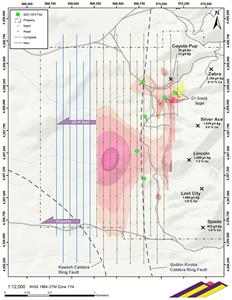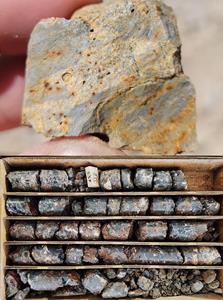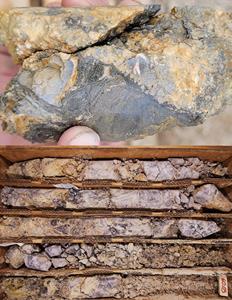VR confirms breccia pipe at G1 gold target at Reveille, extends drilling, and expands the property based on a new 3D DCIP anomaly
VANCOUVER, British Columbia, May 19, 2021 (GLOBE NEWSWIRE) -- VR Resources Ltd. (TSX.V: VRR, FSE: 5VR; OTCBB: VRRCF), the "Company,” or “VR,” is pleased to provide an update on the ongoing exploration at its Reveille silver-copper and gold property in the Walker Lane gold-silver mineral belt in west-central Nevada.
| |
| |
|
Figure 1 shows the new IP anomaly in the covered and unexplored valley west of the Reveille range, the location of drill hole RVD21-001 just completed on the G1 gravity low anomaly, and the three RC holes located immediately to the west which are planned for next week to test the root of the breccia pipe intersected at G1.
Photo 1 and Photo 2 show drill core rubble which illustrates the nature of the breccia pipe intersected from top to bottom in the 110 m drill hole just completed at RVD21-001, starting at surface. Salient features included:
| |
| |
|
The new IP anomaly shown in Figure 1 is robust. The survey included 6 lines and 84 receiver stations on an equant 150 m station grid which generated 84,451 chargeability data points for the 3D inversion models. The Company has extended both the grid and the property farther west as a result. Salient features of the anomaly:
| 450 x 600 m core. | |
| >25 mv/V; maximum of 32 mV/V. | |
| Top of IP anomaly is at the base of the volcanic cover, < 150m from surface. | |
| Epithermal quartz veining and clay alteration of cover rocks is mapped at surface above and peripheral to the new IP anomaly. | |
| Figure 2; the IP anomaly is at the southwest end of the northeast-trending structures which control silver-copper mineralization at the various historic showings exposed at surface in the hills of the Reveille range to the east. |
Figure 2 also shows the locations of the four holes completed earlier this spring for the Phase I RC program (1,325 metres in total). They were collared primarily on magnetic, EM and structural features. The Company has received only a small portion of geochemical assays to date, but expects to have full results from more than 800 samples in the coming weeks, in conjunction with fully processed and interpreted data from the hyperspectral scanning of RC chips used for the mapping of alteration minerals.
CEO Comment
From VR’s CEO, Dr. Michael Gunning, “For our shareholders who have been following Reveille for the past year and who know that our goal has been to apply modern mineral deposit models and new exploration technologies to look for the center of the overall Carlin/CRD mineral system at Reveille, we believe the large and data-robust IP anomaly in Figure 1 is exactly that; the source and the driver for the numerous historic and high grade silver-copper workings in the hills, but located in the covered and previously unexplored valley to the west.
Our expansion of both the property and the IP grid farther west demonstrate our conviction for that potential. Planning for the additional IP work is underway, and we hope to have it completed at the end of May.
We continue down the path of building out Phase II of the drilling at Reveille once we have all geochemistry in hand and interpreted from the first phase of drilling, and now, complete 3D modeling of an expanded DCIP survey westward from the new IP anomaly in the valley. We plan to complete Phase II drilling some time this summer.
In the meantime, our decision to extend the drilling of the G1 gravity low for a gold-bearing jasperoid pipe speaks to our conviction of what we saw in the drill core rubble over the past few weeks; indeed, ground conditions that are tough for the drillers are commonly good for the geologists. We relate the textures and mineral assemblages evident in the drill core photos we show in this news release to the gold-silver-arsenic-antimony-mercury-barium multi-element geochemistry described for the G1 target in our previous news release of April 14th.
Overall, we believe that this G1 drill hole, as difficult as it was to complete, proves the potential for the superposition of a Carlin-style gold fluid system on the CRD silver-copper system at Reveille, with gold-bearing jasperoid breccia hosted on the same regional-scale structures and caldera margin faults as the silver and copper. VR endeavours to bring modern mineral deposit modeling and state-of-the-art exploration technologies to historic and proven districts like Reveille in order to “turn up something new”, and one can see in Figure 1 how the new 3D-array DCIP technology sheds new light on targeting the roots of the G1 breccia pipe for sulfide with gold.
We look forward to providing further updates as our data come in and our drilling advances this summer.”
Context
VR is exploring the covered valley on the western flank of the range because it has never been previously explored or drilled as the potential source and overall driver of the high-grade silver-copper mineralization at Reveille during the past 140 years of prospecting which has focused on the high-grade showings exposed in the hills of the Reveille range to the east.
An array of new geochemical data from rock samples at showings and grid-based soil samples provide element ratio vectors which indicate that the source area to the overall mineral system at Reveille is westward, towards the Kawich Caldera margin (Figure 1). VR is focused squarely on drill-testing new geophysical and structural targets along the range front and in the covered valley immediately to the west for proximal, high temperature silver-copper mineralization, and potentially for a superimposed Carlin-style gold mineral system that is hosted in a diatreme breccia with jasperoid and hosted by the same structures that control the CRD silver-copper fluids.
Technical Information
Summary technical and geological information for the Company’s various exploration properties is available at the Company’s website at www.vrr.ca.
VR has submitted RC chip samples collected from this drill program for geochemical analysis to the Bureau Veritas Minerals (“BV”) laboratory in Sparks, Nevada, where sample preparation is completed. Analytical work
completed at the BV laboratories located in Vancouver, BC., includes ICP-MS analyses for base metals and trace elements, while gold determination is done at the Sparks, NV lab by fire assay atomic absorption spectrometry. Analytical results are subject to industry-standard and NI 43-101 compliant QAQC sample procedures at the laboratory, as described by BV, and with standard, duplicate and blank samples inserted internally by VR.
Technical information for this news release has been prepared in accordance with the Canadian regulatory requirements set out in National Instrument 43-101. Justin Daley, P.Geo., Exploration Manager & Chief Geologist at VR and a non-independent Qualified Person oversees and/or participates in all aspects of the Company’s mineral exploration projects and has reviewed the content of this news release. The Company’s CEO, Dr. Michael Gunning, P.Geo., is also a non-independent Qualified Person.
About the Reveille Property
The Reveille property is located approximately 90 km’s east of Tonopah, Nevada. Access is via Highway 6, with local roads and trails in and around the property itself.
The Reveille property consists of 78 mineral claims in one contiguous block covering 1,586 acres (642 hectares) over an area of approximately 2 x 3 km’s. The property is on federal land administered by the BLM, and are outside of the BLM’s broadly defined area of sage grouse protection. There are no underlying annual lease payments on the property, nor are there any joint venture or carried interests on the property. There is an industry-standard royalty attached to the property, with a standard buy-back provision to VR.
About VR Resources
VR is an established junior exploration company focused on greenfields opportunities in copper and precious metals (TSX.V: VRR; Frankfurt: 5VR; OTCBB: VRRCF). VR is the continuance of 4 years of active exploration in Nevada by a Vancouver-based private company. The diverse experience and proven track record of its Board in early-stage exploration, discovery and M&A is the foundation of VR. The Company focuses on underexplored, large-footprint mineral systems in the western United States and Canada, and is well financed for its exploration strategies and corporate obligations. VR owns its properties outright, and evaluates new opportunities on an ongoing basis, whether by staking or acquisition.
The Company continues its normal course of business in 2021 within the framework of modified exploration programs in response to the COVID-19 pandemic, with the goal of ensuring the health and safety of staff and project personnel.
ON BEHALF OF THE BOARD OF DIRECTORS:
“Michael H. Gunning”
____________________________
Dr. Michael H. Gunning, PhD, PGeo
President & CEO
| For general information please use the following: | |
| Website: | www.vrr.ca |
| Email: | info@vrr.ca |
| Phone: | 604-262-1104 |
Forward Looking Statements
This press release contains forward-looking statements. Forward-looking statements are typically identified by words such as: believe, expect, anticipate, intend, estimate, postulate and similar expressions or are those which, by their nature, refer to future events. Forward looking statements in this release include “the drilling of three additional holes to test the roots of the G1 pipe is planned to start next week.”, and “VR evaluates new opportunities on an ongoing basis, whether by staking or acquisition.”
This news release contains statements and/or information with respect to mineral properties and/or deposits which are adjacent to and/or potentially similar to the Company’s mineral properties, but which the Company has no interest in nor rights to explore. Readers are cautioned that mineral deposits on adjacent or similar properties are not necessarily indicative of mineral deposits on the Company’s properties.
Although the Company believes that the use of such statements is reasonable, there can be no assurance that such statements will prove to be accurate, and actual results and future events could differ materially from those anticipated in such statements. The Company cautions investors that any forward-looking statements by the Company are not guarantees of future performance, and that actual results may differ materially from those in forward-looking statements. Trading in the securities of the Company should be considered highly speculative. Readers are urged to review all of the Company’s public disclosure filings available at www.sedar.com.
Neither the TSX Venture Exchange nor its Regulation Services Provider (as that term is defined in Policies of the
TSX Venture Exchange) accepts responsibility for the adequacy or accuracy of this release
Figure 1 accompanying this announcement is available at https://www.globenewswire.com/NewsRoom/AttachmentNg/6a299321-5442-4110-bc76-055e314a2f17
Figure 2 accompanying this announcement is available at https://www.globenewswire.com/NewsRoom/AttachmentNg/7dfb5894-46a1-417a-807a-351e0a8b0081
Photo 1 accompanying this announcement is available at https://www.globenewswire.com/NewsRoom/AttachmentNg/58653659-c3c0-4521-9a2e-4fe88cc04169
Photo 2 accompanying this announcement is available at https://www.globenewswire.com/NewsRoom/AttachmentNg/b1978eaa-a7f4-49b2-9079-eff7138d4819



